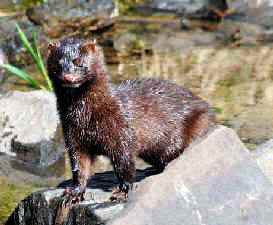Mink are semi-aquatic mammals and members of the weasel family, which include otters, ferrets, badgers, and martens. Minks can be found near rivers, lakes, and marshes throughout North America and Canada. They are found in every part of Alaska except Kodiak Island, the Aleutians Islands, and most of the Arctic Slope.
While mortality is extremely high in the early months of the life of the American mink, animals that do survive the first year can live as long as three years in the wild. In captivity, mink can live 10-12 years and have on average 4-5 kits per litter once a year. The mink is found in places which suit its habits throughout almost all North America, from Florida to the Arctic. An endangered subspecies, the Everglades Mink, is endemic to the Florida Everglades
Mink are glossy, blackish brown with a long slender body, averaging 20-24 inches, with short legs and a long, 7-8 inch bushy tail. The mink has small rounded ears and a white chin and weighs between 3-5 pounds. Several albino mink have been reported from Alaska. Underfur is usually thick and wavy, not longer than an inch. It is dark gray to light brown in color with some suggestion of light and dark bands.
Mink will eat virtually anything they can catch and kill, including fish, birds, bird eggs, insects, crabs, clams, and small mammals. There are both seasonal and annual differences in the diet depending on what is available. Mink prefer streams, ponds, beaches, or marshes. An abundance of hares or mice may cause them to move inland. Adult mink have been known to kill and eat young mink.
Mink are very territorial animals. A male mink will not tolerate another male within its territory, but appears to be less aggressive towards females. Generally, the territories of both male and female animals are separate, but a female's territory may sometimes overlap with that of a male. Very occasionally it may be totally within a male's. The mink's territories, which tend to be long and narrow, stretch along river banks, or around the edges of lakes or marshes. Sizes vary, but they can be several miles long. Female territories are smaller than those of the male. Each territory has one or two central areas (core areas) where the mink spends most of its time. The core area is usually associated with a good food supply, such as a pool rich in fish, or a good rabbit warren.
The mink may stay in its core area, which can be quite small, for several days at a time, but it also makes excursions to the ends of its territory. These excursions seem to be associated with the defense of the territory against intruders. It is likely that the mink checks for any signs of a strange mink and leaves droppings (scats) redolent of its personal scent to reinforce its territorial rights. American minks are mainly active at night and do not hibernate.
In Alaska, northern mink breed about two weeks later than those further south, because onset of breeding is determined by the beginning of long days. The breeding season extends from March through April, depending on the latitude. Males and females may breed with more than one other mink. The young within a single litter can be the result of fertilization by different males and/or two different ovulations more than a week apart. The total gestation period varies from 40 to 75 days. In mink and other weasels, the fertilized egg does not attach to the uterus to develop right away as in most mammals. This delayed implantation accounts for the great variation in length of the gestation period. Once the egg implants, fetal development takes about 30 days to complete.
In Interior and western Alaska most births occur during June. Differences in the abundance of food available to the mother affect the number of young born and the number that are weaned. Litter size varies from 4 to 10 kits. The den is generally a burrow or hollow log near a pond or a stream. In most cases the den used has been constructed and deserted by other animals. At birth, newborn mink are about 0.35 ounces (10 g) and slightly haired. Young mink remain in the den about a month. They grow rapidly and attain their adult size by September. In the following spring they may breed and raise their own young.
Great Horned Owls, bobcat and fox are the natural predators of mink. However, mink are much more frequently killed by human activity. Mink are often hunted to protect the fish population of bodies of water, are hit by cars and are trapped for their fur (although more commonly farmed for their fur). Their numbers have been reduced due to loss of habitat and the effects of pollution on their aquatic food supply. Mink oil is used in some medical products and cosmetics, as well as to treat, preserve and waterproof leather.
|
|








